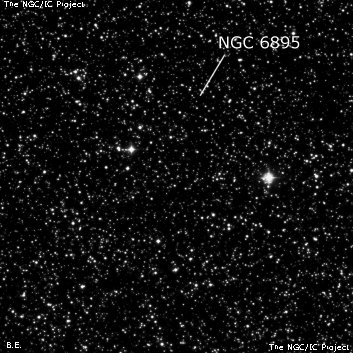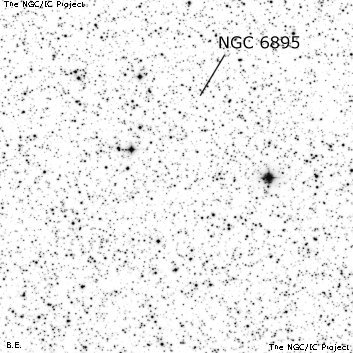NGC/IC Project Restoration Effort
(This is a very very beta version)
NGC6895


Basic Information
Location and Magnitude
Right Ascension: 20:16:32.0
Declination: +50:14:24
Constellation: CYG
Visual Magnitude:
Historic Information
Discoverer: Herschel W.
Year of discovery: 1790
Discovery aperture: 18.7
Observational
Summary description: Cl, pRi, lC
Sub-type: *Grp
Corwin's Notes
=====
NGC 6895 is described by WH as "A cluster of scattered stars, above 15 arcmin
diameter, pretty rich and joining to the Milky Way, or a projecting part of
it." This was the only deep sky object found by WH on 30 September 1790. At
the beginning of the sweep, WH comments that "The heavens [are] extremely rich
in S stars", and about 20 minutes after his observation of the cluster, he
notes "The Aurora borealis is so bright that it eclipses the small stars in
the field."
When I went over the field before, I found "Centered close to his position (I
put the center about 2 arcmin northeast) is a large cloud of stars, about 20
by 18 arcminutes, most likely a random clump in the Milky Way. Four SAO
stars, and dozens of fainter stars are included." The cloud that I see now is
about a minute of time west of WH's position and is more or less centered on
HD 192983. The size I estimated earlier is about right, so I wonder if I too
made an error of one minute in RA.
Whatever happened, the current "cluster" fits WH's description nicely, and is
just a minute of time off his position, a common digit error. So, I've taken
this as WH's object, correcting my earlier position by a minute of time.
Steve's Notes
=====
NGC 6895
24" (7/29/16): at 124x (49' field): this Milky Way field includes mag 6.4 HD 192983. A 4' circular group with over a dozen mag 11-12.5 stars is ~5' W. An elongated group of mag 11-13 stars is 5' SE of the bright star. A larger "U" shaped group of stars (open to the north), including mag 8.2 HD 193216 and three additional mag 9-10 stars is ~12' NE. The overall field is fairly rich, but unimpressive with nothing that resembles a cluster.



